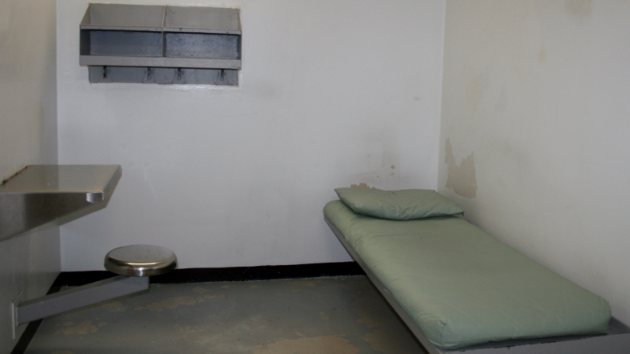Phu Pham was hallucinating badly. Little gray rabbits stared up at him. Vivid cityscapes materialized in the stone-hard carpeting of his 10-foot-diameter pod, and instant-messaging gibberish scrolled across its translucent wall panels. “You’re seeing all this crap,” recalls the diminutive 23-year-old photographer. “It’s scary.” Pham had never been so tired. In two days of isolation, he’d been allowed just a few hours of sleep and minimal food. He’d been treated to the amplified screams of infants and hours stuffed into a small box that kept getting hotter. Those first days, he recalls, were when he most wanted out. But Phu Pham is no quitter.
Endure isolation and a series of arduous physical and psychological “treatments” until you break. That’s the gist of Solitary, a made-for-TV competition that concluded its second season last September and is headed for a third this fall on the Fox Reality Channel, a network spin-off that airs reality shows 24/7. The brainchild of producers Andrew Golder and Lincoln Hiatt, Solitary places nine men and women in cramped pods for up to 12 days with no human contact. “Guests,” their names reduced to numbers, must instead submit to Val—a female spin on Hal, the sentient computer from the sci-fi classic 2001—who serves as host, enabler, and oppressor. (Hiatt calls her “a benevolent bitch.”)
In season one, after softening up her charges, Val delivers the first treatment. Players are allowed to sleep but are awakened repeatedly by earsplitting alarms; to stop the onslaught, they must regurgitate a numeric code that grows more complex with each cycle. After hours of this, Number 4, a tough 30-year-old Romanian immigrant, mutters, “This is a psychotic-experiment show, not a reality show.”
It gets worse—or better, depending on your perspective. Bleary-eyed contestants must scrutinize a video montage of horrors to solve an equation. They complete hundreds of sickening revolutions on a sit-and-spin apparatus. They lie for hours on a bed of wooden pegs; a Buddhist martial arts instructor deems the pain “intolerable.” Players can quit anytime by hitting a big red button mounted in their pods, but to do so means going home with only the phone number of a consulting psychologist. The last person standing leaves with $50,000.
The show’s creators bill Solitary as a harmless “social experiment,” that red button rendering bogus any comparisons to actual torture. In fact, they say, some players find the isolation therapeutic. “I know many make choices about changing their lives after they’ve been in Solitary, dumping bad boyfriends and focusing on their careers,” Hiatt says. “If we could, we’d open Solitary camps as therapy retreats around the country, because it seems to work.”
Andrew Golder jokes that Solitary is “the best reality show on television that nobody’s watching.” Fox Reality won’t reveal its ratings, even to the producers, except to say Solitary has exceeded expectations. (Golder allows that the audience is 55 percent female and that it grew steadily during season two.) Whatever its viewership, the show has drawn little media attention apart from Boston Herald TV critic Mark Perigard asking last August, “What, no waterboarding?”
The creators had hoped to avoid such allusions. When Solitary was in development, Abu Ghraib was still a fresh wound, and they treaded carefully, nixing direct references to prisons, cells, inmates, and above all, the t-word. But hey, controversy sells. “You want to get the tailwind of the whole cultural zeitgeist,” Golder says. “We wanted people to be aware of us and think we were this scary—’torture’ is never a word we’d say—but sort of very tough television show.”
In fact, the program’s most brutal aspect isn’t the physical treatments but rather Val’s manipulations, her monopoly on information. On most competitive reality shows, a player knows when the others have quit, but on Solitary, four contestants are left to agonize on the “bed of nails” for 90 minutes even after a fifth has given up and made the others winners. This twist creates a complex psychological dynamic. As Hiatt describes it, “Where does the drive for victory succumb to the instinct for self-preservation?”
For viewers who can get past the guilt factor, Solitary has its moments. Disoriented and stripped of control, players shed their inhibitions with results that range from depressing to perversely funny. When Val prods second-season contestants to address their dietary staple—a loathed “nutritious food block”—a gung-ho Survivor alum named J.P. acts out a mock interrogation.
Drill sergeant: “ASS BAR! Let me ask you this! Do you know you taste like shit?”
Bar: “SIR! Yes SIR!”
Sarge: “Why do we still keep getting ’em?”
Bar: “SIR! I don’t know, SIR!”
Sarge (stomping on the block): “Wrong answer, ass bar!”
Near-starved contestants are asked to list their favorite foods, which include bananas and yogurt, cheeseburgers, sushi, gummy worms, and Vietnamese tripe soup. When the dishes finally are served, they come blended together; contestants consume the disgusting smoothies until they puke.
In one of the more visually disturbing treatments, contestants spend hours in simulated torture chairs, drooling through ball gags. “Thith ith torthure!” spits a humiliated Pham. “Thith thucks!” To which Val replies in a soothing voice, “I agree. This rocks!” Pham shrieks in response like some frustrated pachyderm, and it’s hard not to laugh. He wanted this, after all.
Early last April, when Val told Pham he’d won Solitary 2.0, he sobbed for 25 minutes. He was exhausted, but also elated, because conquering a reality show was among his life goals. The youngest of three siblings and the first born in the United States, Pham is a devotee of the genre. Unlike season-one contestants, who had no idea what was coming, he had studied the show and even trained by cutting back on sleep and ditching his Chapstick, which he applies compulsively during our interview at his parents’ home in Moreno Valley, a middle-class suburb east of Los Angeles.
After nailing two casting interviews, Pham recalls, he signed a 30-day contract and endured a battery of tests. Doctors drew blood, gave him a cardio ultrasound, and measured his lung capacity. He met with a show psychologist and still recalls some of the scores of written questions. Do you ever have the urge to kill anyone? Do you hear voices at night?
But it was Val’s voice that haunted his dreams after he left the show. Even eight months later, Pham still has conflicting emotions. While he didn’t find his isolation therapeutic, he says it was worthwhile simply for the experience. Even at the depths of his pain and humiliation, he could appreciate the show’s entertainment value. “It’s very hard to explain,” he says of the ball gag, which he cites as both a high and low point. “You’re trying to ham it up and let yourself have fun, entertain them, making the best of a pretty horrible situation. It’s like when you’re on death row. How sad can you be on death row? You’ve got to at least have as much fun as you can when you know you’re coming to an end.”
Stanford University psychologist Phil Zimbardo might classify Pham’s attitude as a rationalization. The professor emeritus is best known for his 1971 Stanford Prison Experiment, wherein students were divided into two groups—guards and prisoners—and placed in a mock prison setup. Within days, the students were subsumed by their roles. The guards turned cruel and the prisoners suffered emotional breakdowns rather than walk away, as they were free to do. “They became prisoners,” Zimbardo recalls.
He hasn’t watched Solitary—the reality genre is distasteful in his view—but he was repelled by what I told him about it. “My sense is it’s a debasement of human nature, and it doesn’t matter if the process is a competition, a game show, or a war,” he says. Nor does Zimbardo buy Hiatt’s claim that Solitary has therapeutic value. “Is it therapeutic for me to shit on you?” counters the psychologist. “Well, yeah, because then you realize you’re not as prideful as you thought you were.
I’m standing on the front steps of Andrew Golder’s ocean-view home in Pacific Palisades watching a slate-tiled fountain pour a sheet of water into a wishing well. Hiatt pulls up in a blue Land Rover, followed by Golder in a Mercedes.
The path from Golder’s front door to his living room is obstructed by a cardboard box for a baby crib. Hiatt also is a recent father. Those infant screams that plagued Pham and his cohorts? Hiatt’s twins. “I would get up in the middle of the night as the babies were crying, and my wife thought I was going to pick them up and comfort them,” he says with an impish grin. “Instead I was recording audio.”
Golder credits Debt for a Lifetime, a Jeopardy parody he produced in 1995, for reviving a flagging game-show genre. He’s also behind Win Ben Stein’s Money and Identity, an NBC game show hosted by comedian Penn Jillette. Hiatt got his break doing a kids’ game show called Funhouse. More recently, he created Unan1mous, a top-10 program on what the two call “Big Fox.” They first worked as a team during the 1990s on an ill-fated revival of Let’s Make a Deal and later collaborated on Comedy Central’s Don’t Forget Your Toothbrush.
Their initial Solitary concept was far from comedic; indeed, it was likely among the darkest ideas ever pitched to a TV executive. They proposed burying 10 cells in a desolate location such as the Salton Sea with nothing visible from the surface but a row of ventilation shafts. “From the sky,” Hiatt marvels, “the thing would look like a bizarre alien graveyard.” Contestants would be allowed sleep and food but would remain (hidden cameras aside) in utter isolation: no treatments, no Val, no nothing. “When they want to leave, they walk out into the light, and the last person to walk out into the light wins,” Golder explains. (He and Hiatt habitually point out that contestants who participate in Solitary do so of their own free will.) “It was a very draconian social experiment.”
The pitch tanked. “I think they basically thought, ‘You’re fucking crazy!'” says Golder. That was in late 2004. The concept languished until the summer of 2005, when Golder met with executives of the new Fox Reality Channel. For their first original series, the suits wanted something edgy, something nobody else would touch. “I don’t know exactly what I said,” Golder recalls, “except ‘we take a group of people and we put them in isolation, and we watch what happens.'” The execs were intrigued. Could he and Hiatt deliver a treatment in seven days?
Val was born that week as a way to propel the drama and keep the contestants engaged. “We loved it,” says Bob Boden, Fox Reality’s senior vice president of programming, production, and development. “It had a catchy title, and it was producible on our limited budgets. We couldn’t recall another show that was about confinement, about lacking human contact.”
By Hiatt’s assessment, viewers approach Solitary with one of two mentalities: “‘I want to be there,’ or ‘Oh my God! I’m sure glad I’m not there.’ Both are compelling reasons to watch,” he says. Zimbardo offers a darker theory: Viewers relate to Val. “That’s what people are attracted to, the fact that somebody has the power to get somebody else to do these things,” he says. “‘Look at what we can get ordinary American people to do for a lousy $50,000!’ You know what? Some of them would do it simply to be the winner of the game on Fox television.”
He’s right. According to Hiatt, six of the nine season-one contestants later told the producers they’d have done Solitary for free. Hiatt sees something noble in this: By fostering competition outside the “fabric of society,” he says, the show gives people the chance to be “exceptional.”
Besides, Golder adds, the treatments aren’t too dangerous, at least according to the doctors and psychologists who vet every activity and every contestant. “Obviously we didn’t want to hurt anybody in any way, shape, or form,” he says. That desire reflects genuine empathy, liability concerns, and the knowledge that a mishap would, in Golder’s words, “invalidate some of the value of what we’re trying to create.” On other shows, a medical team can rush in to assist an injured participant, but to do so on Solitary would destroy the show’s fundamental premise of isolation. “We can’t break the seal,” Hiatt says.
In maintaining that seal, the Solitary team has left many ideas on the drawing board. One nixed by the medics involved having players grip a block of ice. “After a while it’s not going to hurt anymore,” Hiatt explains. “Because you’re killing the nerves that send a signal to your brain that says, ‘Don’t hold onto the stupid block of ice, you idiot!'” Another reject involved having a contestant’s loved one read a prepared script; the resulting audio would be edited into a track saying that someone had died or that a spouse was leaving him. “It’s a funny idea, but it’s just like, okay, that’s probably wrong,” he says.
Then he reassesses. Honestly, Hiatt admits with a laugh, he doesn’t think that last one goes too far. “I guess it’s just a matter of taste.”
















